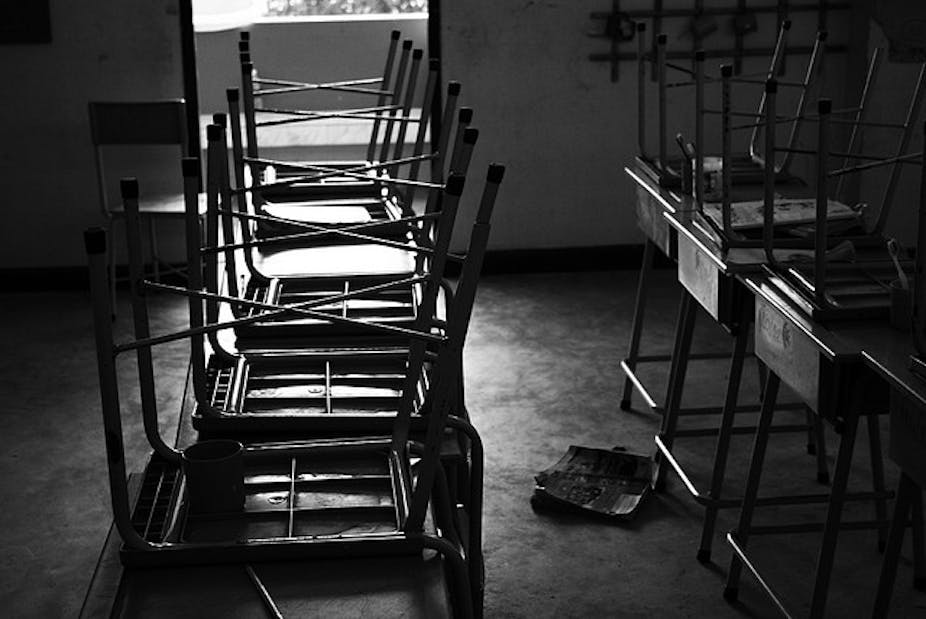Where I come from in North Carolina it is currently 14 hours behind Australian Eastern Standard Time. I tell my colleagues that I have come from the past. However, when it comes to seeing how the failed educational policies in the UK and US have landed on Australian shores, I add that I may be from the past but I have seen the future.
What can we learn from my ventures in the past? We should reverse some of our current thinking that a “good school” is one that emphasises testing and test preparation first, at the expense of high-quality teaching and powerful, inspiring learning. The failed testing regimen that has swept the UK and US shows mostly negative results, particularly for those who learn differently, are gifted, have special needs, have an economic hardship or who come from minority groups.
What we know from research on the UK and US models after 20 years of failed policy is that children who are poor in the UK and US and who attend schools with other children who are poor, are less likely to do as well on state or national tests as those children who are wealthy and who go to school with other wealthy kids.
In Australia we have time to respond and get schooling right for everyone. In order to do so, we should be wise to trends that have jeopardised public education elsewhere in the world.
1. We’re listening to bad ideas
The education policies being proposed in Australia are part of an international movement. The interdependence of the world’s economies has allowed a seamless flow of bad ideas to move across borders. International think tanks funded by multinational corporations and their foundations now govern the direction of school reform.
We’ve seen evidence of this in the US with the American Legislative Exchange Council, 50CAN and NewsCorp. The push for high-stakes testing is an effort to control the agenda for working- and middle-class students, treating them as dumbed-down commodities.
2. Markets are for profit, not learning
There’s a privatisation movement going on all over the world, which Australia seems to be emulating. Some in the UK, US and Australia see this as a “liberal versus conservative” debate. This is a battle to privatise the public space, from airports to roads to parks to schools.
The private sector and increasing majorities of officials in state and national legislatures are winning public opinion based on the assumption that government cannot “get it right”. Therefore, anything that can be driven by the free market should be. But the free market is designed to increase profits, not learning.
3. Choice isn’t always democratic
These same think tanks and policy makers are pushing for choice in the market, including rapid implementation of private sector approaches to schooling. Their rhetoric claims that public schools are managed by stubborn teachers’ unions and large bureaucracies that have lost their way.
In effect, the rise of new government-funded school models (called charter schools in the US) and the issuance of vouchers (government subsidies to families to attend private schools in lieu of public schools in the US) are equivalents of a tax deduction for the wealthy.
Private companies are gobbling up charters in the US, leading to for-profit educational centres run as franchises, with academic results mostly worse than traditional public schools in the same postal codes. Poor children are doing worse on average in these reforms from London to New Orleans.
4. Testing instead of teaching
We’ve created testing centres instead of learning centres. For months prior to testing dates, teachers — under strong pressure from school leaders - guide their students in monotonous and ineffective repetition of key content, numbing those who have mastered the material and disenfranchising those who still need to be taught. Continuous test preparation minimises teaching time and becomes a self-fulfilling destiny for children who are poor or who learn differently. And many of our most talented students are bored with school and not maximising their potential.
The Programme for International Student Assessment (PISA) data has created an international trend comparison culture. However, tests used around the world are so varied, with inconsistent administration and questionable validity, that it is inappropriate to use PISA results as primary evidence of school success or failure.
5. Misusing the data
Since high-stakes accountability took hold in the UK, the US and Australia, educators have clamoured for a long-term lens through which to view student performance, rather than in one-year increments. “Value-added”, which attempts to project an individual student’s test scores for a current year from past results, has increasingly become the baseline used to judge teachers and schools in the US under the Obama administration’s Race to the Top initiative.
Value-added can be used to compare a learner’s growth over time; it is limited, however, as a tool to connect the dots directly to effective teaching. And because the data are couched in statistical mumbo-jumbo, non-educators assume the models are foolproof.
Value-added is not the solution to improving on-demand high-stakes assessments. It hasn’t worked elsewhere and is doomed to fail here.
Schooling needs to be reframed around a more future-focused agenda. This would enable young people to learn and to apply their learning in the global innovation age. Reframing education would ensure that when the next ideas come ashore from the UK and US, they won’t be automatically adopted as “good”.
Australia has a brief window in which to choose the best models from inside and outside the country. We should not accept theories that have already failed in countries that are going backwards on the journey to educate all of their people.

